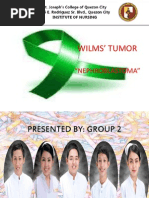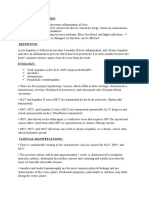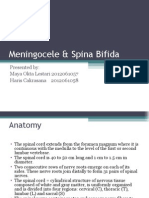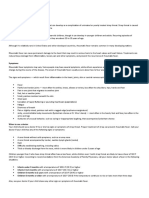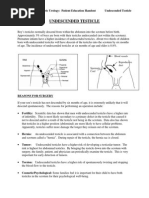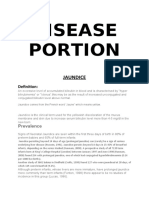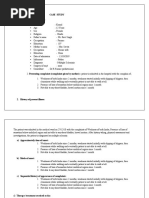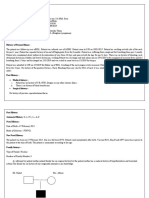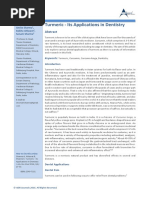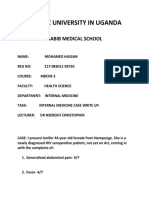Submitted To:-Submitted By: Ms Jahanara Maam MS - Meena Asst. Professor M.SC (Nursing) 2 Yr
Submitted To:-Submitted By: Ms Jahanara Maam MS - Meena Asst. Professor M.SC (Nursing) 2 Yr
Uploaded by
Meena KoushalCopyright:
Available Formats
Submitted To:-Submitted By: Ms Jahanara Maam MS - Meena Asst. Professor M.SC (Nursing) 2 Yr
Submitted To:-Submitted By: Ms Jahanara Maam MS - Meena Asst. Professor M.SC (Nursing) 2 Yr
Uploaded by
Meena KoushalOriginal Description:
Original Title
Copyright
Available Formats
Share this document
Did you find this document useful?
Is this content inappropriate?
Copyright:
Available Formats
Submitted To:-Submitted By: Ms Jahanara Maam MS - Meena Asst. Professor M.SC (Nursing) 2 Yr
Submitted To:-Submitted By: Ms Jahanara Maam MS - Meena Asst. Professor M.SC (Nursing) 2 Yr
Uploaded by
Meena KoushalCopyright:
Available Formats
SUBMITTED TO:- SUBMITTED BY:
Ms Jahanara Maam MS.Meena
Asst. Professor M.sc (nursing)2nd Yr
INTRODUCTION
Paediatric oncology is the branch of medicine
concerned with the diagnosis and treatment of cancer in
children. Childhood cancers are a rare but important
cause of morbidity and mortality in children younger
than 15 yrs. of age.
Common childhood malignancies
include leukaemia’s (30-40%), brain
tumours (20%) and lymphoma
(12%) followed by neuroblastoma,
retinoblastoma and tumours
arising from soft tissues, bones and
gonads
Cancer is a group of diseases involving
abnormal cell growth with the potential to
invade or spread to other parts of the body.
These contrast with benign tumours,
which do not spread to other parts of the
body.
Possible signs and symptoms include a
lump, abnormal bleeding, prolonged
cough, unexplained weight loss and a
change in bowel movements.
Types of oncological disorder in children :-
Neuroblastoma
Wilms tumour
Non-Hodgkin lymphoma
Hodgkin lymphoma
Childhood rhabdomyosarcoma
Retinoblastoma
Osteosarcoma
Ewing sarcoma
Germ cell tumour
Pleuropulmonary blastoma
Hepatoblastoma and hepatocellular carcinoma
NEUROBLASTOMA
Neuroblastoma is the most common intra-
abdominal and extra cranial solid tumour
in children, and the most common
tumour in infancy. Neuroblastoma and
related neoplasms arise from those neural
crest cells which differentiate in to cells of
the sympathetic ganglia and adrenal
medulla.
ETIOLOGY
Neuroblastoma is derived from neural
crest cells that form the adrenal medulla
and the sympathetic nervous system. The
cause is unknown.
Most cases occur in young children; thus,
it is likely that neuroblastoma results from
prenatal and perinatal events.
PATHOPHYSIOLOGY
Neuroblastomas are soft, solid tumours originating
from neural crest cells that are precursors of the
adrenal medulla and sympathetic nervous system.
Neuroblastomas can occur where sympathetic
nervous tissue is found.
The majority of tumours are usually in the
abdomen, either in the adrenal gland or the
sympathetic ganglia.
Less common primary sites include the paraspinal
area of the thorax, the neck, and the pelvis.
Neuroblastomas often impinge on adjacent tissues
and organs and can metastasize to the lymph nodes,
bone, bone marrow, and/or subcutaneous tissue.
Researchers are studying genetic mutations in the
neuroblastoma cells as they seek to identify the
etiology of neuroblastoma.
CLINICAL MANIFESTATIONS
•Symptoms related to abdominal mass
•Firm, irregular abdominal mass that crosses midline
•Altered bowel and/or bladder function
•Vascular compression with oedema of lower extremities
•Back pain, weakness of lower extremities
•Sensory loss
•Loss of sphincter control
•Symptoms related to neck or thoracic mass
•Cervical and supra clavicular lymphadenopathy
•Congestion and oedema of face
•Respiratory dysfunction and/or distress
•Ecchymotic orbital proptosis
•Horner’s syndrome (unilateral ptosis, myosis,
andanhidrosis)
•Symptoms related to metastasis to bone and/or
bonemarrow
•Fatigue
•Pain
•Fever
•Symptoms related to catecholamine secretion
•Hypertension
•Sweating
•Flushing
•Irritability
COMPLICATIONS
•At diagnosis: Depending on the location of the
tumor, neuromuscular complications can include:
•lower-extremity weakness or paralysis.
•A hematologic complication is metastasis to lymph
nodes, bone, and bone marrow.
•During treatment: Adverse events from
chemotherapy, radiation therapy, and/or surgery can
be life-threatening.
•Infection and
•Organ toxicities.
STAGES
Stage I: Localized tumor confined to the area of origin;
complete excision, with or without microscopic residual
disease; identifiable and contra lateral lymph nodes
negative microscopically
Stage II: Localized tumor with incomplete gross
excision; identifiable ipsilateral and contra lateral lymph
nodes negative microscopically
Stage IIB: Localized tumor with complete or incomplete
gross excision with positive ipsilateral regional lymph
nodes; identifiable contralateral lymph nodes negative
microscopically
Stage III: Tumor infiltrating across the midline
with or without regional lymph node
involvement; or unilateral tumour with
contralateral regional lymph node involvement;
or midline tumor with bilateral regional lymph
node involvement
Stage IV: Tumor disseminated to distant lymph
nodes, bone, bone marrow, liver or other organs
(except stage IVS).
Stage IVS: Localized primary tumor as defined
for stage 1 or2 with dissemination limited to
liver, skin and/ or bone marrow(only in infants)
TREATMENT
•Age and clinical stage are the two most important
independent prognostic factors. Even with advanced disease,
children less than 1-yr-old at diagnosis have a better outcome
than those diagnosed later. Treatment modalities for
neuroblastoma include chemotherapy, surgery and radiation
therapy.
•Localized neuroblastoma has better prognosis; it can be
treated with surgery alone and does not require
chemotherapy. Observation alone is needed for stage 4S
patients.
•Chemotherapy is the chief therapy for most patients with
neuroblastoma in advanced stage. Chemotherapy includes
vincristine and alkylating agents in combination with
anthracycline and epipodophyllo toxins.
Chemotherapy regimens widely used are OPEC
(vincristine, cyclophosphamide, cisplatinum,
teniposide (VM-26), CADO (vincristine,
cyclophosphamide, doxorubicin) and PECADO
(vincristine, cyclophospharnide, doxorubicin,
cisplatinum, teniposide),etc.
Other modalities include surgery, radiotherapy
and autologous bone marrow transplantation.
HODGKIN LYMPHOMA
INTRODUCTION
Hodgkin’s disease (HD) is a malignant disorder of
lymphoreticular system. Hodgkin’s disease occurs
in 5 to 7 per 1,00,000 population.
It is very uncommon under 5 years of age and
almost never seen under 2 years of age.
In asian population, HD is common even at
younger ages.
The WHO classification of Hodgkin
lymphoma recognizes two major
subtypes:
(i) Nodular lymphocytic-predominant
Hodgkin lymphoma (NLPHL),
(ii) Classical Hodgkin lymphoma.
(i) Nodular lymphocytic-predominant Hodgkin
lymphoma (NLPHL),
NLPHL is most common in males younger than 10
years. Patients with NLPHL generally present with
localized, non-bulky disease. Almost all patients are
asymptomatic.
(ii) Classical Hodgkin lymphoma.
The hallmark of classic Hodgkin lymphoma is
the Reed-Sternberg cell. This is a binucleated or
multinucleated giant cell that is often
characterized by a bilobed nucleus, with two large
nucleoli, giving an owl’s eye appearance to the
cells.
CAUSES
•Variation in the incidence of HD in different
ethnic groups and
•association with human leukocyte antigen
suggests that inherited susceptibility plays an
important role in the pathogenesis.
•Environmental factors such as Epstein-Barr
virus infection, familial clustering of cases
and
•higher incidence in twins may be some of
the other contributing factors.
CLINICAL MANIFESTATIONS
•Lymphadenopathy, usually in the cervical,
supraclavicular, and mediastinal areas; mediastinal
presentation common in adolescents and young adults;
significant mediastinal adenopathy may cause cough,
dyspnea,
• Painless, movable lymph nodes in tissues surrounding
involved area
•Unexplained fever
•Weight loss
•Drenching night sweats
•Malaise
•Painless cervical or supraclavicular lymphadenopathy
STAGES OF HODGKIN LYMPHOMA
STAGE DESCRIPTION
S
I Involvement of single lymph node region (I) or of single extralymphatic or site (IE)
by direct extension
II Involvement of two or more lymph node regions on the same side of diaphragm or
localized involvement of an extra-lymphatic organ or site and of one or more lymph
node regions on the same side of the diaphragm
III1 Involvement of lymph node regions on both sides of the diaphragm Abdominal
disease is limited to the upper abdomen (i.e. spleen, splenic nodes, celiac nodes, porta
hepatitis nodes)
III2 Involvement of lymph node regions on both side of the diaphragm Abdominal
disease includes para aortic, mesenteric, and iliac involvement with or without
disease in the upper abdomen.
IV Disseminated involvement of one or more
Extralymphatic organs or tissues with or without associated lymph node disease.
DIAGNOSIS
1. Complete blood count
2. Erythrocyte sedimentation rate (ESR
3. Serum copper, iron, calcium, and alkaline phosphatase
4. Liver and renal function tests
5. Urinalysis
6. Chest radiographic study
7. Computed tomography—to evaluate mediastinal, pulmonary, and
abdominal disease
8. Gallium and/or positron emission tomography (PET) scan to
determine the extent of involvement
9. Excisional lymph node biopsy—essential to diagnosis and staging
10. Bone marrow biopsy if patient has stage 3 or 4 disease according to
imaging studies
TREATMENT
Treatment of HD in paediatric population is
different in certain respects from adults. Devising the
ideal therapeutic approach for children with HD is
complicated by their increased risk for late adverse
effects.
Treatment modalities have varied from total nodal
radiation therapy to chemotherapy to combination of
chemotherapy and radiotherapy with significant
improvement in survival rate throughout the last
three decades.
All children generally receive combination
chemotherapy as initial treatment.
Inparticular, radiation therapy can cause
profound musculoskeletal growth retardation
and increase the risk for cardiovascular disease
and secondary solid malignancies in children.
desire to cure young children with minimal side
effects has stimulated attempts to reduce the
intensity of chemotherapy(particularly
alkylating agents) and radiation dose or volume.
In general, the use of combined chemotherapy with
radiation broadens the spectrum of potential
toxicities, while reducing the severity of individual
drug relatedor radiation-related toxicities. Current
approaches use chemotherapy alone with or
without low-dose involved-field radiation therapy
(LD-IFRT).
The volume of radiation and the intensity/duration
of chemotherapy are determined by prognostic
factors at presentation, including presence of
constitutional symptoms, disease stage, and bulk.
NURSING MANAGEMENT
NURSING ASSESSMENT
1. Assess child’s physiologic status.
a. Signs and symptoms of Hodgkin’s disease
b. Involvement of other body systems (e.g.,
respiratory,gastrointestinal)
c. Adverse effects of treatment
2. Assess family’s psychosocial needs.
a. Knowledge and education level
b. Body image
c. Family structure
d. Family stressors
e. Coping mechanisms
f. Support systems
3. Assess child’s developmental level .
4. Assess family’s ability to manage home care.
NURSING INTERVENTIONS
Staging Procedure
1. Provide preprocedural education to child and family
2. Prepare child for clinical staging procedures with
age-appropriate approach .
3. Assist and support child in collection of laboratory
specimens.
4. Provide instruction, support, and family crisis
intervention.
RADIATION AND CHEMOTHERAPY PHASE
1. Provide sedation for radiation treatments if needed.
2. Monitor cardio respiratory status during treatments.
3. Prepare for treatment-induced emergencies.
a. Metabolic disturbances, though Hodgkin’s disease is
generally low risk for tumor lysis syndrome
b. Hematologic disturbances, such as febrile neutropenia,
severe anemia
c. Space-occupying tumors, specifically superior vena cava
syndrome
4. Assess for signs of extravasation of chemotherapeutic
agents.
a. Edema, erythema, pain at infusion site
b. Tissue sloughing
5. Monitor for signs and symptoms of infection.
6. Assess skin integrity.
7. Minimize side effects of radiotherapy and chemotherapy.
a. Bone marrow suppression
b. Nausea and vomiting
c. Anorexia and weight loss
d. Oral mucositis
e. Pain
8. Provide ongoing emotional support to child and family.
9. Refer to child life specialist to assist with continued
coping strategies.
10. Provide ongoing education about treatment and follow-
up care, medications—both chemotherapy and supportive
care medications.
11. Refer family to social services for support and resource
utilization.
12. If school age, refer to hospital or home bound teacher or
obtain lessons for teaching.
NON-HODGKIN LYMPHOMA
INTRODUCTION
Non-Hodgkin’s Lymphoma (NHL) is neoplasm of
a wide range of cell types that comprise the immune
system.
Non-Hodgkin lymphoma (NHL) comprises a
heterogeneous group of lymphoid neoplasm's
derived from cells of the immune system. NHL most
commonly occurs during the second decade of life
and occurs less frequently in children less than three
years of age.
Together with Hodgkin lymphoma they comprise
the third most common childhood malignancy.
NHL of childhood currently falls into three
therapeutically relevant categories:
(1) B-cell NHL (Burkitt lymphoma/ leukaemia
and diffuse large B-cell lymphoma);
(2)Lymphoblastic lymphoma (primarily
precursor T-cell lymphoma and, less frequently,
precursor B-cell lymphoma); and
(3) Anaplastic large cell lymphoma (T-cell or
null-cell lymphomas).
CAUSES
B cells and T cells.
Non-Hodgkin's lymphoma can begin in the:
•B cells: B cells fight infection by producing
antibodies that neutralize foreign invaders.
Most non-Hodgkin's lymphoma arises from B
cells.
•T cells: T cells are involved in killing
foreign invaders directly. Non-
Hodgkin's lymphoma occurs less
often in T cells.
SIGN AND SYMPTOMS
Intra abdominal Involvement
•Possible symptoms mimicking appendicitis
(pain, right lower quadrant tenderness)
•Intussusception
•Ovarian, pelvic, retroperitoneal masses
•Ascites
•Vomiting
•Diarrhoea
•Weight loss
Mediastinal Involvement
•Pleural effusion
•Tracheal compression
•Superior vena cava syndrome
•Coughing, wheezing, dyspnea,
respiratory distress
•Edema of upper extremities
•Mental status changes
Primary Nasal, Paranasal, Oral,
and Pharyngeal
Involvement
•Nasal congestion
•Rhinorrhea
• Epistaxis
•Headache
• Proptosis
•Irritability
•Weight loss
STAGES
The most widely used staging scheme for childhood non-
Hodgkin lymphoma (NHL) is that of the St. Jude Children’s
Research Hospital (Murphy’s Staging), which is outlined in
Table
STAGE DESCRIPTION
Single tumour (extranodal)Single anatomic area(nodal)
I excluding mediastinum or abdomen
II Single tumor (extranodal) with regional node
involvement. Primary gastrointenstinal tumour with
or without involvement of mesentric node.or
On same side of diaphragm:
a. Two or more nodal areas
b. Two single extra nodal tumours with or without
regional node involvement
III All primary intrathoracic tumours. All extensive
primary intra-abdominal disease. Two or more
nodal or extranodal areas on both sides of
diaphragm
IV Any of the above with CNS or bone marrow
DIAGNOSIS
•Bone marrow biopsy—to identify malignant cells
withbone marrow involvement
•Lumbar puncture—to determine presence of
malignantcells in CNS
•Complete blood count—diagnostic for bone marrow
dysfunction; may show elevated white blood cell
count, decreased hemoglobin level, hematocrit, and
platelet count
•Liver and kidney function tests—liver function test
values may be elevated with liver involvement;
kidney function test values may be elevated with
kidney involvement
•Lactate dehydrogenase level—elevated owing to
tumour lysis
•Serum uric acid level—elevated owing to cellular
tumourload
•Epstein-Barr virus test—positive result has been
associatedwith NHL
•Bone scan—to determine the presence of
metastases in thebone
•Chest radiograph—to determine the presence of
metastases in the lung
•Computed tomography and magnetic resonance
imaging—to determine the presence of metastases
in other areasof the body
TREATMENT
Childhood NHL is an extremely chemo
sensitive disease. Surgery plays a very limited
role, mainly for arriving ata diagnosis.
Radiation of primary sites is used very rarely
in emergency situations. Hence, multi-agent
chemotherapy directed to the histologic
subtype and stage of the disease remains the
corner stone of therapy.
There are two potentially life-threatening
clinical situations that are often seen in
children with NHL:
•superior vena cava syndrome (SVCS) often
seen in lymphoblastic lymphoma; and
•Tumour lysis syndrome, most often seen in
lymphoblastic and Burkitt NHL. These
emergent situations should be anticipated in
children with NHL and addressed immediately
NURSING MANAGEMNET
NURSING ASSESSMENT
1. Assess child’s physiologic status.
a. Signs and symptoms of NHL
b. Involvement of other body systems (e.g., gastrointestinal,respiratory)
c. Adverse effects of treatment
d. Signs and symptoms of tumour lysis syndrome (hypocalcemia,
hyperphosphatemia, hyperkalemia, hyperuricemia)
2. Assess child and family for psychosocial needs:
a. Knowledge of disease and treatment regimen
b. Body image
c. Family structure
d. Family stressors
e. Coping mechanisms
f. Support systems
3. Assess child’s level of development .
NURSING DIAGNOSE
•Risk for injury
•Imbalanced Nutrition: less than body
requirements
•Anxiety
•Activity intolerance, Risk for
•Therapeutic regimen management,
Ineffective
•Ineffective coping
NURSING INTERVENTIONS
Diagnosis and Staging Phase
1. Provide preprocedural education to child and family
2. Prepare child for diagnostic procedures with age-
appropriateapproach
3. Observe for signs and symptoms of systems involvement.
a. Respiratory distress
b. Superior vena cava syndrome
c. CNS changes
4. Refer to child life specialist as appropriate for
preproceduralpreparation.
5. Assist and support child in collection of laboratory
specimens.
6. Provide anticipatory guidance and family crisis
intervention.
TREATMENT PHASE
1. Monitor cardiorespiratory status.
2. Prepare for treatment-induced emergencies.
a. Metabolic crises
b. Hematologic crises
c. Space-occupying tumours
3. Administer chemotherapeutic agents
4. Assess for signs of extravasation.
a. Cell lysis
b. Tissue sloughing
5. Minimize side effects of chemotherapy.
a. Bone marrow suppression
b. Nausea and vomiting
c. Anorexia and weight loss
d. Oral mucositis
e. Pain
6. Monitor for signs and symptoms of infection.
6. Monitor for signs and symptoms of infection.
7. Monitor for signs and symptoms of relapse.
a. CNS changes
b. Infection
c. Tumour recurrence
d. Leukemic conversion
8. Provide ongoing emotional support to child and family
9. Refer to child life specialist for continued coping strategies.
10. Provide ongoing education about treatment
andMedications
11.Refer family to social services for support and
resourceutilization.
12. Monitor for tumour lysis syndrome
SUMMARY
The cancer treatment is based on the type of cancer
and the stage of the cancer. In some people, diagnosis
and treatment may occur at the same time if the cancer
is entirely surgically removed when the surgeon
removes the tissue for biopsy.Although patients may
receive a unique sequenced treatment, or protocol, for
their cancer, most treatments have one or more of the
following components: surgery, chemotherapy,
radiation therapy, or combination treatments (a
combination of two or all three treatments).
Palliative therapy (medical care or treatment
used to reduce disease symptoms but unable
to cure the patient) utilizes the same
treatments described above.
CONCLUSION
Cancer can be treated with the help of certain
medicines ; chemotherapy and surgery of the
cancer. The prognosis (outcome) for cancer
patients may range from excellent to poor. The
prognosis is directly related to both the type
and stage of the cancer. However, as the cancer
type either is or becomes aggressive, with
spread to lymph nodes or is metastatic to other
organs, the prognosis decreases
THANK YOU
You might also like
- Case by Case Examination by Padeniya SirDocument287 pagesCase by Case Examination by Padeniya SirtharikaneelawathuraNo ratings yet
- SET UP niCUDocument16 pagesSET UP niCUMeena Koushal100% (4)
- Lymphoma in ChildrenDocument42 pagesLymphoma in ChildrenPriyaNo ratings yet
- HydronephrosisDocument12 pagesHydronephrosisChithra SajuNo ratings yet
- Ophthalmia NeonatorumDocument30 pagesOphthalmia NeonatorumManish ShresthaNo ratings yet
- Wilms TumorDocument38 pagesWilms TumorEjay Jacob Ricamara0% (1)
- Non Hodgkin Lymphoma in ChildrenDocument4 pagesNon Hodgkin Lymphoma in ChildrenMilzan MurtadhaNo ratings yet
- Rheumatic Heart DiseaseDocument31 pagesRheumatic Heart DiseaseMeena Koushal100% (1)
- CASE Study ENCEPHALITISDocument29 pagesCASE Study ENCEPHALITISMeena Koushal80% (5)
- Hirschsprung Disease (Congenital Aganglionic Megacolon) : PathophysiologyDocument2 pagesHirschsprung Disease (Congenital Aganglionic Megacolon) : PathophysiologyDiane Mary S. Mamenta100% (1)
- Pediatric AIDSDocument51 pagesPediatric AIDSapi-3823785100% (1)
- Hepatitis in ChildrenDocument2 pagesHepatitis in ChildrenShilpi SinghNo ratings yet
- Dengue Case StudyDocument77 pagesDengue Case StudyFaith TorralbaNo ratings yet
- Erythroblastosis Case StudyDocument19 pagesErythroblastosis Case StudyMaricel Agcaoili GallatoNo ratings yet
- Management of Dengue Fever in Children PDFDocument41 pagesManagement of Dengue Fever in Children PDFnakalnakal2015No ratings yet
- Failure To ThriveDocument4 pagesFailure To ThriveShane PangilinanNo ratings yet
- Meningocele & Spina BifidaDocument20 pagesMeningocele & Spina BifidaAstrid SabirinNo ratings yet
- Childhood CancerDocument19 pagesChildhood CancerSREEDEVI T SURESHNo ratings yet
- CranioplastyDocument2 pagesCranioplastyLaila munazadNo ratings yet
- Diaphragmatic HerniaDocument14 pagesDiaphragmatic HerniaReinhaMaeDaduyaNo ratings yet
- Causes: Neonatal Jaundice or Neonatal Hyperbilirubinemia, or Neonatal Icterus (From The GreekDocument7 pagesCauses: Neonatal Jaundice or Neonatal Hyperbilirubinemia, or Neonatal Icterus (From The GreekIzzah100% (1)
- Epidemiology, Pathogenesis, and Pathology of NeuroblastomaDocument21 pagesEpidemiology, Pathogenesis, and Pathology of NeuroblastomaHandre PutraNo ratings yet
- ANENCEPHALYDocument10 pagesANENCEPHALYSharmaine Simon100% (1)
- Spina Bifida: By: Eloisa Anne N. Recto & Ane Kyla M. WaminalDocument23 pagesSpina Bifida: By: Eloisa Anne N. Recto & Ane Kyla M. WaminalKrizia Ane SulongNo ratings yet
- Hypospadias and EpispadiasDocument3 pagesHypospadias and EpispadiasJulliza Joy PandiNo ratings yet
- Respiratory Distress SyndromeDocument121 pagesRespiratory Distress Syndromeinno so qtNo ratings yet
- Case Presentation On Autosomal Recessive Polycystic Kidney Disease (ARPKD)Document15 pagesCase Presentation On Autosomal Recessive Polycystic Kidney Disease (ARPKD)narseya100% (1)
- B. SC Nursing: Medical Surgical Nursing Unit V - Disorders of The Cardio Vascular SystemDocument31 pagesB. SC Nursing: Medical Surgical Nursing Unit V - Disorders of The Cardio Vascular SystemPoova Ragavan100% (1)
- Hemolytic Disease of The NewbornDocument16 pagesHemolytic Disease of The NewbornStanculescu MarianaNo ratings yet
- Neonatal SepsisDocument5 pagesNeonatal SepsisBhawna PandhuNo ratings yet
- Pathophysiology of Spinal Cord Injury 1Document1 pagePathophysiology of Spinal Cord Injury 1Kristian Karl Bautista Kiw-isNo ratings yet
- Wilm's TumorDocument17 pagesWilm's TumorRaquel M. Mendoza100% (1)
- Case60 Down SyndromeDocument9 pagesCase60 Down Syndromegreenflames09100% (2)
- Seminar 2 Endocrine DisordersDocument44 pagesSeminar 2 Endocrine DisordersSuganthi ParthibanNo ratings yet
- NEONATAL APNOEA SMNRDocument18 pagesNEONATAL APNOEA SMNRAswathy RC100% (1)
- Hirschsprung DiseaseDocument44 pagesHirschsprung DiseaseAhmad Abu KushNo ratings yet
- PediculosisDocument28 pagesPediculosisLucy PalmaNo ratings yet
- Abdominal Wall DefectsDocument16 pagesAbdominal Wall DefectsDesta FransiscaNo ratings yet
- Rheumatic FeverDocument3 pagesRheumatic FeverKennette LimNo ratings yet
- Reye SyndromeDocument10 pagesReye SyndromeDanil KhairulNo ratings yet
- Body Temperature PDFDocument56 pagesBody Temperature PDFBanupriya-No ratings yet
- Pediatric PneumoniaDocument3 pagesPediatric PneumoniaErika GardeNo ratings yet
- Congenital HypothyroidismDocument36 pagesCongenital HypothyroidismRandi DwiyantoNo ratings yet
- Hiv Infection in PediatricsDocument44 pagesHiv Infection in Pediatricskrishna chandrakaniNo ratings yet
- Puerperal SepsisDocument4 pagesPuerperal SepsisSonali NayakNo ratings yet
- DiphtheriaDocument36 pagesDiphtheriaDr. SAMNo ratings yet
- NeuroblastomaDocument4 pagesNeuroblastomaGeleine Curutan - OniaNo ratings yet
- Undescended TestisDocument2 pagesUndescended TestisdyarraNo ratings yet
- Lecture 11 Failure To Thrive (FTT)Document25 pagesLecture 11 Failure To Thrive (FTT)jaish8904100% (2)
- Necrotizing EnterocolitisDocument46 pagesNecrotizing EnterocolitisEzekiel Arteta100% (1)
- Respiratory Distress Syndrome in A Premature BabyDocument29 pagesRespiratory Distress Syndrome in A Premature BabyVissalini JayabalanNo ratings yet
- Intrauterine Growth Restriction IUGRDocument8 pagesIntrauterine Growth Restriction IUGRJyoti Prem UttamNo ratings yet
- Hirschsprung's Disease (Aganglionic Megacolon)Document3 pagesHirschsprung's Disease (Aganglionic Megacolon)JOANMA_NEWNo ratings yet
- Hirsch Sprung Disease NewDocument10 pagesHirsch Sprung Disease NewUday KumarNo ratings yet
- Rheumatic FeverDocument15 pagesRheumatic FeverJeaneta Cheryl PatrickNo ratings yet
- Wilms Tumour: Nitha K 2 Year MSC NursingDocument40 pagesWilms Tumour: Nitha K 2 Year MSC NursingNITHA K100% (1)
- BIRTH INJURIES FinalDocument48 pagesBIRTH INJURIES FinalAlvin OmondiNo ratings yet
- Mecocium Aspiration SyndromeDocument13 pagesMecocium Aspiration SyndromeSANANo ratings yet
- Diabetes Mellitus, Diabetes Insipidus and Diabetic Ketoacidosis in ChildrenDocument62 pagesDiabetes Mellitus, Diabetes Insipidus and Diabetic Ketoacidosis in ChildrenGie GenoNo ratings yet
- ScabiesDocument38 pagesScabiesSiti Sabrina AtamiaNo ratings yet
- Non-Hodgkin Lymphoma Rhabdomyosarcoma Retinoblastoma: by Derrota, Keith Angelo CDocument39 pagesNon-Hodgkin Lymphoma Rhabdomyosarcoma Retinoblastoma: by Derrota, Keith Angelo CKeith Angelo Canete Derrota100% (1)
- K27 - On. K26b. The LymphomasDocument32 pagesK27 - On. K26b. The LymphomasJosephine IrenaNo ratings yet
- Presentation_20241103_144536_0000Document47 pagesPresentation_20241103_144536_0000Kashaf RoyyanNo ratings yet
- "Cancer 101: What You Need to Know About Causes, Symptoms, and Prevention"From Everand"Cancer 101: What You Need to Know About Causes, Symptoms, and Prevention"No ratings yet
- A Statutory Body Under The Aegis of Ministry of Health and Family Welfare, GOIDocument1 pageA Statutory Body Under The Aegis of Ministry of Health and Family Welfare, GOIMeena KoushalNo ratings yet
- NCP JaundiceDocument9 pagesNCP JaundiceMeena Koushal100% (1)
- NC JaundiceDocument9 pagesNC JaundiceMeena KoushalNo ratings yet
- Assessment Nursing Diagnosis Planning Nursing Interventions Rationale EvaluationDocument5 pagesAssessment Nursing Diagnosis Planning Nursing Interventions Rationale EvaluationMeena KoushalNo ratings yet
- Assessment Nursing Diagnosis Planning Nursing Interventions Rationale EvaluationDocument5 pagesAssessment Nursing Diagnosis Planning Nursing Interventions Rationale EvaluationMeena KoushalNo ratings yet
- Disease PEMDocument16 pagesDisease PEMMeena KoushalNo ratings yet
- Disease JaundiceDocument19 pagesDisease JaundiceMeena KoushalNo ratings yet
- Nursing Care PlanDocument21 pagesNursing Care PlanMeena KoushalNo ratings yet
- Disease Rheumatic Heart DiseaseDocument20 pagesDisease Rheumatic Heart DiseaseMeena KoushalNo ratings yet
- Case Study 1. Patient Bio-DataDocument28 pagesCase Study 1. Patient Bio-DataMeena KoushalNo ratings yet
- Nurses Notes: Signature:-Ms. Rita Date:-10/1/2020 Time: - 7amDocument1 pageNurses Notes: Signature:-Ms. Rita Date:-10/1/2020 Time: - 7amMeena KoushalNo ratings yet
- Records of Nurses: Signature:-Ms. Rita Date:-10/1/2020 Time: - 7amDocument1 pageRecords of Nurses: Signature:-Ms. Rita Date:-10/1/2020 Time: - 7amMeena KoushalNo ratings yet
- NCP On LBWDocument22 pagesNCP On LBWMeena Koushal100% (3)
- Name-Age/Sex - MRD No. - Date of Admission - Ward - Address - Diagnosis - History Taking History of Present IllnessDocument17 pagesName-Age/Sex - MRD No. - Date of Admission - Ward - Address - Diagnosis - History Taking History of Present IllnessMeena KoushalNo ratings yet
- Nurses RECORDSDocument1 pageNurses RECORDSMeena KoushalNo ratings yet
- Development of Problem-Solving Ability Problem Solving ProcessDocument8 pagesDevelopment of Problem-Solving Ability Problem Solving ProcessMeena KoushalNo ratings yet
- Physical Layout PICUDocument7 pagesPhysical Layout PICUMeena KoushalNo ratings yet
- Organization Chart: Importance of Organizational StructureDocument9 pagesOrganization Chart: Importance of Organizational StructureMeena KoushalNo ratings yet
- Case Presentation RVFDocument15 pagesCase Presentation RVFMeena Koushal100% (1)
- Physical Layout PICUDocument8 pagesPhysical Layout PICUMeena Koushal0% (1)
- Nicu Physical LayoutDocument16 pagesNicu Physical LayoutMeena Koushal100% (5)
- Turmeric - Its Applications in DentistryDocument4 pagesTurmeric - Its Applications in DentistryAdvanced Research PublicationsNo ratings yet
- Toxic Epidermal Necrolysis (TEN) & SJS - DR Pankaj AIIMS, New DelhiDocument82 pagesToxic Epidermal Necrolysis (TEN) & SJS - DR Pankaj AIIMS, New DelhiDr Pankaj Chaturvedi100% (3)
- 001 - Skin AnatomyDocument46 pages001 - Skin AnatomyLucas Victor AlmeidaNo ratings yet
- Hypertension Secrets (Edgar v. Lerma, James M. Luther Etc.) (Z-Library)Document244 pagesHypertension Secrets (Edgar v. Lerma, James M. Luther Etc.) (Z-Library)oscar3spurgeonNo ratings yet
- Rosenberg 1979Document6 pagesRosenberg 1979Aliénor VienneNo ratings yet
- Dysuria Stat PearlsDocument7 pagesDysuria Stat PearlsAvika MuharrahmahNo ratings yet
- SESSION 13-Diarrhea DiseaseDocument29 pagesSESSION 13-Diarrhea Diseasegbunyara100No ratings yet
- Cardiology Lectures 1 4 DR - Deduyo PDFDocument31 pagesCardiology Lectures 1 4 DR - Deduyo PDFMiguel Cuevas DolotNo ratings yet
- Chapter 29 NEUROMUSCULAR AND OTHER DISEASE OF THE CHEST WALLDocument5 pagesChapter 29 NEUROMUSCULAR AND OTHER DISEASE OF THE CHEST WALLZahra Margrette SchuckNo ratings yet
- Disentri Amoeba TUTORDocument26 pagesDisentri Amoeba TUTORShameer Mohamed AljabarNo ratings yet
- Usefulness of Biomarkers of Exposure To Inorganic Mercury Lead or Cadmium in Controlling Occupational and Environmental Risks of NephrotoxicityDocument13 pagesUsefulness of Biomarkers of Exposure To Inorganic Mercury Lead or Cadmium in Controlling Occupational and Environmental Risks of NephrotoxicityNuvita HasriantiNo ratings yet
- Cystic FibrosisDocument62 pagesCystic FibrosisSydney PellosisNo ratings yet
- Topik CKD Staga 4-5Document24 pagesTopik CKD Staga 4-5antoajaNo ratings yet
- Management of Hepatocellular CarcinomaDocument21 pagesManagement of Hepatocellular CarcinomaOlgaNo ratings yet
- Whooping CoughDocument3 pagesWhooping CoughfLOR_ZIANE_MAENo ratings yet
- Primary Care of Musculoskeletal Problems in The Outpatient SettingDocument350 pagesPrimary Care of Musculoskeletal Problems in The Outpatient SettingMauriceGatto100% (1)
- Both Young and Old RBC Young RBC Young RBC Old RBC: Rizal ST., Albay Dist., Legazpi CityDocument3 pagesBoth Young and Old RBC Young RBC Young RBC Old RBC: Rizal ST., Albay Dist., Legazpi CityAbegail ListancoNo ratings yet
- High Altitude IllnessDocument9 pagesHigh Altitude Illnesswana_iswaraNo ratings yet
- Prelim ReviewerDocument4 pagesPrelim ReviewerChristian Dominic HernandezNo ratings yet
- Islamic University in Uganda: Habib Medical SchoolDocument8 pagesIslamic University in Uganda: Habib Medical SchoolUsaid SulaimanNo ratings yet
- Chronic Kidney Disease (Newly Identified) - Clinical Presentation and Diagnostic Approach in Adults - UpToDateDocument30 pagesChronic Kidney Disease (Newly Identified) - Clinical Presentation and Diagnostic Approach in Adults - UpToDatePatrick SánchezNo ratings yet
- ATI Flash Cards 10, Medications Affecting Digestion and NutritionDocument22 pagesATI Flash Cards 10, Medications Affecting Digestion and NutritionSue PadgettNo ratings yet
- Properties of The Timed Up and Go' Test: More Than Meets The Eye.Document8 pagesProperties of The Timed Up and Go' Test: More Than Meets The Eye.Diane Troncoso AlegriaNo ratings yet
- LECTURE 22: Antipsychotic Agents & Lithium: OutlineDocument5 pagesLECTURE 22: Antipsychotic Agents & Lithium: OutlineRosa PalconitNo ratings yet
- Deexcc Eczema: Allergic Contact Dermatitis (ACD)Document4 pagesDeexcc Eczema: Allergic Contact Dermatitis (ACD)Jansher Ali ChohanNo ratings yet
- What Is Your Diagnosis and Suggestions From History, Lab Investigation, and Ultrasound Scan?Document4 pagesWhat Is Your Diagnosis and Suggestions From History, Lab Investigation, and Ultrasound Scan?Dagnechew DegefuNo ratings yet
- PaclitaxelDocument4 pagesPaclitaxelAdditi SatyalNo ratings yet
- Frequencies For FSMDocument5 pagesFrequencies For FSMtd5xb7w4dp100% (2)
- Pug's Genetic Health BookDocument44 pagesPug's Genetic Health BooknicolasfloNo ratings yet





